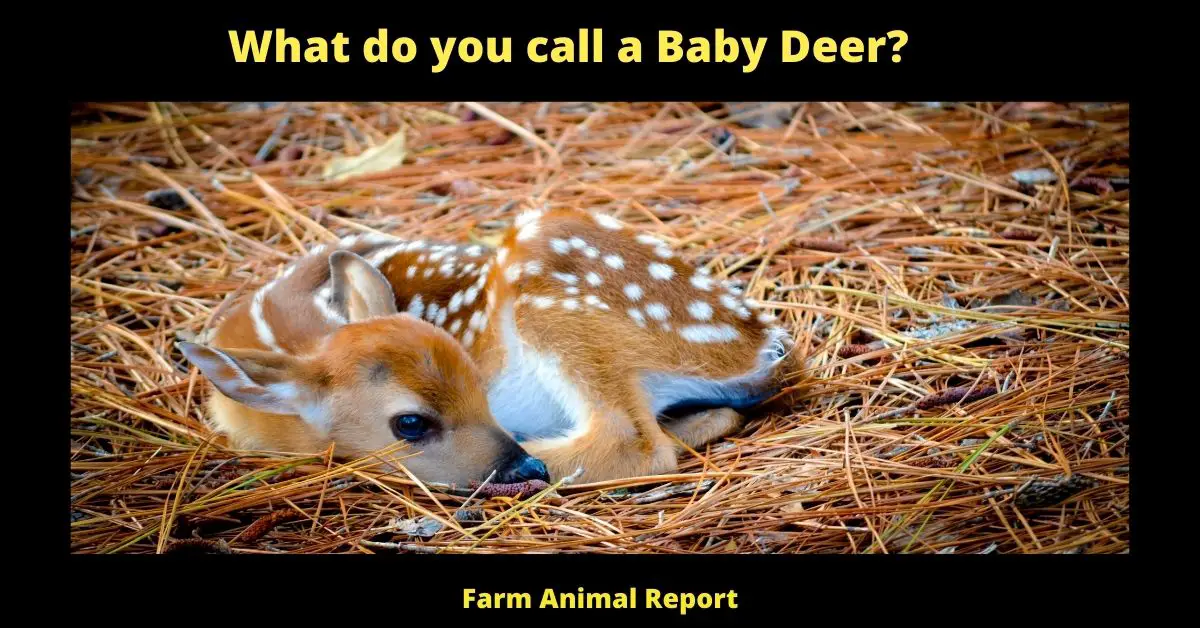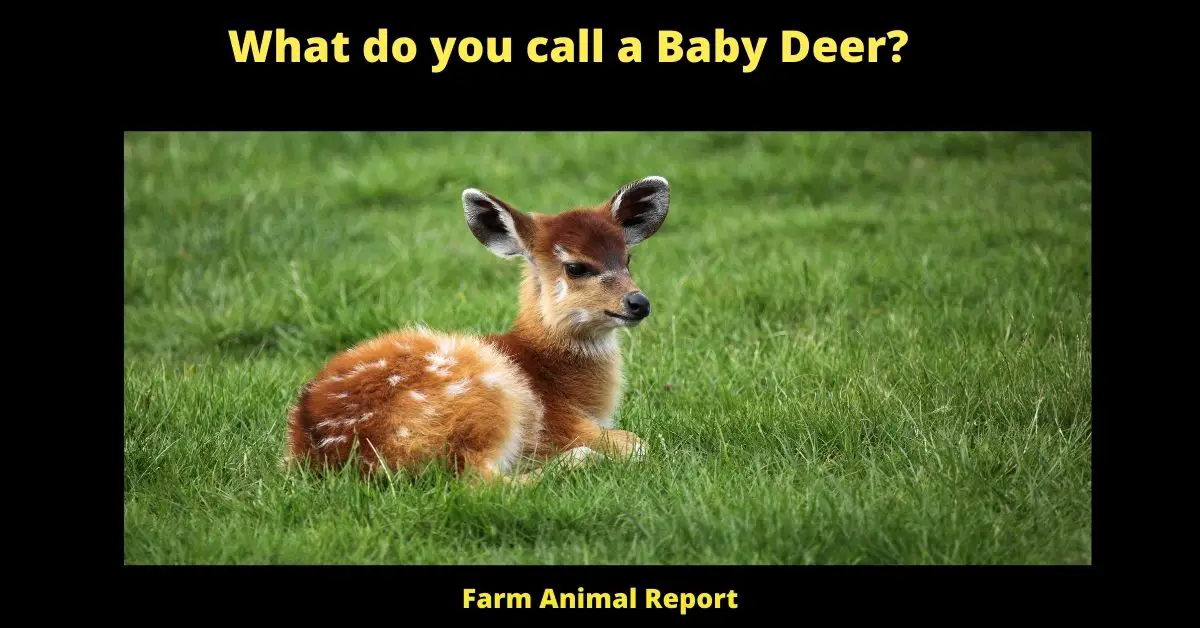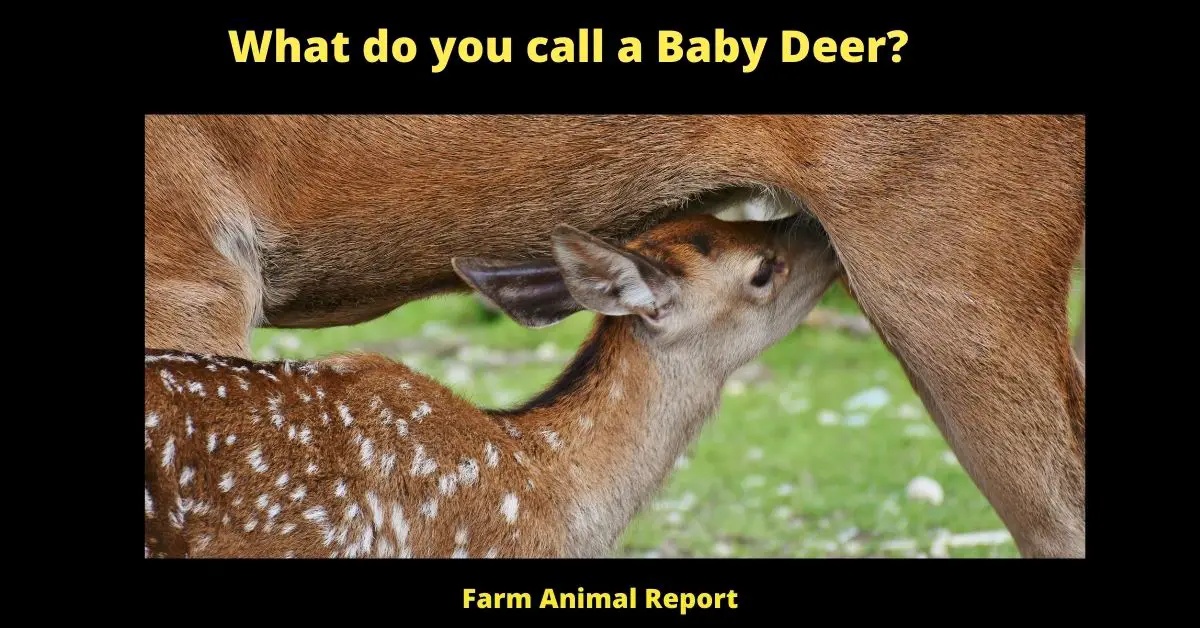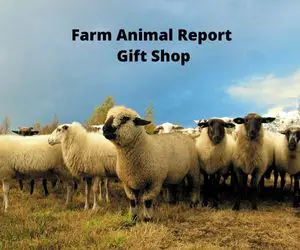Baby Deer Name – A Baby Deer is Called A variety of terms refers to newborn/juvenile deer. “Fawn” is the most often used word for a young deer; however other names for baby deer include “calf” and “kid,” respectively. Depending on the kind of deer in question, as well as where you are in the globe, you may determine the most accurate name for a juvenile deer, as well as what you should call it.
Baby Deer Name | What do you call a Baby Deer?
Deer are pretty magnificent creatures to watch. While there are many different species of deer found worldwide, including elks, water deer, white-tailed deer, moose, and reindeer, each of these mammals is easily distinguishable in its natural environment. Baby Deer Name. Baby Deer is Called
Unlike antelopes, who are recognized for their gentle nature, most grownup deer are distinguished by their large antlers and powerful physique. However, even though they are not the largest or most deadly animals in their environment, they have developed their own methods of living in the wilderness.
Jump to 7 Ways to Make Money Deer Farming
In the same way that many other animals are incorrectly classified, many individuals may be unfamiliar with the proper term for deer. A proper English noun may be used to refer to a baby deer and a herd of deer. Baby Deer Name
Check Out Amazons Educational Books on Whitetail Deer
Continue reading to find out what a baby and group of deer are referred to as in English, as well as how to locate one in its natural environment. Keep in mind that there are around 50+ species of deer, and their nouns may differ from one country to the next.

Let’s find out what baby deer are commonly called or in native English.
Let’s take a look at these often-used words to describe baby deer. What do you call a Baby Deer?
Fawn | Fawns | Baby Deer Name
· Fawn: Fawns are the young of small and medium-sized deer species, such as the white-tailed deer, roe deer, and muntjac deer. Old French noun faon, which literally translates as “a baby animal,” was altered to become the term “fawn.” It is also derived from the English verb faunen, which literally translates as “to joy” or “to be pleased.”
Calf | Baby Deer Name
Calf: Deer that are larger in statures, such as the elk, moose, black deer, reindeer, and red deer, refer to their young as calves. On the other hand, the term calf is not restricted to the deer species. Elephants, giraffes, dolphins, and cows are among the animals whose young are referred to as “calf” also.
Kid | Baby Deer Name
· Kid: Baby deer are sometimes referred to as “kids” because they are about the same size as a newborn human child and because baby goats are frequently referred to as “kids,” which may be somewhat similar to baby deer. It is more suitable to refer to a newborn deer as a fawn or a calf rather than as a youngster when referring to a baby deer.
This is a less common and less accurate term for a baby deer than the others. The baby of a doe learns to stand within the first 15-30 min of its mother’s birth. It takes a week for them to walk at the same rate as their mother. As younglings, fawns are afraid of being separated from their mothers or of being left behind, and they remain close to their mothers at all times.
It takes around one year for a fawn to reach maturity. Male fawns grow up to be stags, and they move on to establish their own herd. The majority of the time, stags do not come home or see their moms ever again.
Female fawns grow up to become does, and they are responsible for finding their own partner. Doe’s occasionally return to their moms after the death of their mate or if the doe decides to abandon her stag. They may even bring their own fawns with them to create a small herd.
What does a Baby Deer Look Like? Animal | Male Deer Called | Baby Deer Name
Usually, white patches are present on newborn fawns or calves. This pattern resembles the streaks of lighter/darker shadows cast by trees, thus concealing the newborn deer from predators and keeping them safe.
Fawns will lose their white patches within the first year of their lives, and their coat will become more uniform in color. Another trait of newborn baby deer is that they do not have a scent, which makes it difficult for other animals to discover them.
It is estimated that the average weight of fawns is between six and seven pounds, with male fawns being somewhat heavier than female fawns on average.
Describe the birthing of a Baby Deer | Facts (Baby Deer Stay)
Usually, the mother deer searches for a calm spot in the meadow where she may give birth to her offspring. She lay on her side and prepared herself to give birth. When two-thirds of the baby is exposed, the doe stands up, allowing the fawn to fall out by its own weight. It is usual for a doe to give birth to two fawns.
She cleans and feeds them as soon as she gets them. The doe takes the fawns deeper into the meadow after a few hours, as soon as they have gained enough strength to do so. She places them in different spots, sometimes more than forty meters apart. She does this to keep them safe. This precaution guarantees that if one of the fawns is discovered by a predator, the other fawn will be rescued.
Depending on their age, the doe nourishes her young two or three times a day. She uses her tongue to softly massage the fawns’ bowel and bladder motions, which helps them to move more freely.
She had encouraged her fawns to eat themselves while standing up by the second day. In the hours following feeding time, the fawns lie immobile in the grass for hours at a time while the doe monitors the meadow, keeping an eye out for predators such as the fox.
The only thing that protects the fawns from predators is their camouflage coloring and the absence of nearly any scent (as discussed above). They are able to evade the fox’s notice by keeping still. It has been proven that remaining motionless is beneficial. The fox is scared away by the vigilant mother, who diverts it away from the area.

Humans provide a far larger threat to the young fawns than do other animals. When the farmer discovers the fawn in time, he wraps it in the hay so that it does not pick up a human scent and takes it to a safe location away from danger. The fawn’s distressed cry alerts the doe to the fact that it has been located. The fact that she feeds her young quickly reassures her, which is a frequent behavioral reaction across many animals.
What is the Diet of a Baby Deer? Animal
Fawns are fed milk during the first six months of their lives, after which they transition to eating grasses, herbs, and twigs. Fawns are born weighing between 6 and 7 pounds. They gain two times their body weight in the first two weeks of birth by only consuming their mother’s milk, which is high in fat, sugar, and protein.
After one month, they will have gained three times their original weight. Once they’ve reached the age of a few weeks, they begin nibbling on fragile grasses and fresh shoots, but only enough to get their stomach working.
For the first few weeks of their lives, wild fawns entirely rely on their mothers for all their needs. The mother nourishes the fawn around six times a day, enabling it to nurse until it has consumed its allotted nutritional intake.
What Does a baby Deer Sound Like?
Fawn sounds depends upon the situation:
· During times of happiness, the fawn produces bleating sounds similar to that of goats but at a higher pitch than their moms’ own bleating. Fawns’ bleating is invariably an indication of happiness, and they do it when they are playing with their moms or associating with other fawns.
· When they are sad or in danger, fawns let out a piercing, persistent wail that may sound as weird as a human’s cry at times. If you pass by, you may believe that you see a human person in distress from a distance. The sound is sharp and clear, mainly if it is recorded during the cold nighttime hours.
When Does a Baby deer Leave its mother?
White-tailed deer fawns are typically weaned at the age of two to three months. An adult deer’s grayish-brown winter coat takes the place of a fawn’s spotted winter coat in the early fall months. The majority of female fawns remain with their moms for two years, whereas young bucks leave after a year.
What is Baby Deer Meat Called?
Deer meat is usually termed venison.
What is the proper name for a Group of Deer?
A group of deer is usually called a herd. On the other hand, some deer species dwell in smaller groups and have too few individuals to be termed a true herd. A herd of deer may also be referred to as a parcel of deer. However, the proper collective noun for this group of deer is either “herd” or “parcel,” depending on where you are in the world.
Other Related Tags
- antlers male deer
- male deer called
What is a Baby Deer Called
Most people are familiar with adult deer, but did you know that baby deer have a special name? They are called fawns. Fawns are born in the spring, and they are typically around 20 inches long and weigh between 5 and 10 pounds.
They are born with spots on their fur, which helps to camouflage them from predators. The spots typically fade as the fawn grows older. Fawns stay with their mothers for the first few months of their lives, and they typically begin to eat solid food when they are around 3 months old.
After 6 months, they are fully grown and ready to live on their own. So next time you see a cute little baby deer, you can call it a fawn!
Why Do We Call Baby Deer Fawns?
The word “fawn” comes from the Old French word faon, meaning young animal. It’s thought that this word was originally used to describe young deer, although it can now be used to refer to any young animal.
There are several reasons why baby deer are called fawns. For one, they’re incredibly cute, with their big eyes and soft fur. But there’s more to it than that. Fawns are also born with spotted coats, which help them to camouflage in the vegetation and avoid being seen by predators.
The spots eventually fade as the fawn gets older, but for their first few months of life, they provide an important form of protection. So next time you see a baby deer, remember that they’re not just called fawns because they’re cute – they’re also named for their ability to blend in and stay safe from harm.
What are the Characteristics of a Baby Deer?
Baby deer, or fawns, are born mostly helpless, with their eyes closed and only rudimentary ability to stand and walk. Nevertheless, they are quick learners and within a few days are able to follow their mothers around.
Fawns have spotted coats which provide camouflage against predators; the spots eventually fade as the fawn grows older. Baby deer are born relatively small, weighing only four to eight pounds (two to four kilograms), but they grow quickly, gaining up to three pounds (one and a half kilograms) a week during their first few months.
Although they are active and playful, fawns spend much of their time hiding in tall grass or under bushes, where they are safe from predators. When they are threatened, fawns may freeze in place rather than run away, relying on their camouflaged coats to keep them safe.
If this doesn’t work, the mother deer will often try to distract the predator by leading it away from her baby. Once the baby deer is old enough to fend for itself, it will join a group of other young deer known as a “bachelor herd.”
Females will usually stay with their mothers until they are ready to breed; males will eventually leave the herd to form their own groups. Baby deer are cute and furry, but it’s important to remember that they are wild animals and should not be approached or handled without proper caution.
How Long do Baby Deer stay with their Mother?
In the wild, baby deer stay with their mothers for up to two years. During this time, the mothers teach their offspring how to find food and avoid predators.
The young deer also learn important social skills, such as how to interact with other members of their herd. Once they reach adulthood, they will leave their mothers and strike out on their own. However, if they encounter difficulties or danger, they can always return to the safety of the herd.
How can you tell if a Young Deer is Male or Female?
One of the most common questions asked by new deer hunters is how to tell the difference between a buck and a doe. The antlers are the most obvious way to tell the gender of an adult deer, but in young deer, this method is not always reliable. One way to determine the gender of a young deer is by looking at the shape of its face.
Bucks typically have a more angular face, while does tend to have a softer, rounder face. Another way to tell the difference is by looking at the size of the deer.
Bucks are usually larger than does, though there can be some overlap. Finally, bucks tend to have darker fur than does, though this can also vary depending on the time of year and the individual deer.
By taking all of these factors into account, you can get a good idea of whether a young deer is male or female.
How can you tell the age of a Young Deer?
There are a few key indicators that can help you to estimate the age of a deer. The first is the size of the animal. Young deer are typically smaller than adults, so if you’re looking at a deer that’s on the smaller side, it’s likely to be younger. Another clue is the color of the fur. Young deer tend to have brighter, more vibrant-colored fur, while adults often have duller coats. Finally, you can look at the antlers. Bucks (male deer) start to grow antlers when they’re around six months old, so if you see a buck with antlers, you can be reasonably sure that it’s at least six months old. By keeping an eye out for these clues, you’ll be better able to determine the age of a deer next time you’re out in the woods.
What is Baby Deer Meat Called?
Baby deer meat is an incredibly delicious and delicate treat. While the term “venison” generally refers to the meat of adult deer, there is no equivalent term for the meat of young deer.
This is because the flavor of baby deer meat is so unique that it deserves its own name. Baby deer meat is incredibly tender, with a delicate flavor that is unlike anything else. For this reason, it is prized by hunters and gourmets alike.
If you are lucky enough to find some baby deer meat, be sure to savor it! It is truly a one-of-a-kind delicacy.
7 Baby Deer Facts
1. Fawns are born without spots.
2. It takes fawns about two weeks to be able to walk properly.
3. A fawn’s coat helps it camouflage in the wild.
4. Fawns can jump as high as 3 feet in the air when they’re startled.
5. A fawn’s mother only feeds it for a few minutes at a time so that predators won’t be able to find it easily.
6. A fawn can drink up to 12 quarts of milk a day.
7. A fawn’s heart beats approximately 120 times per minute when it is born, and slows down to 80 beats per minute by the time it is one week old.
Fawn: A fawn is a baby deer that is typically born in the spring. Fawns are born with spots on their fur, which helps them camouflage in the woods. The spots usually fade as the fawn gets older.
Buck: A buck is a male deer that has reached adulthood. Bucks usually have antlers, which they use to attract mates and defend themselves from predators
.
Doe: A doe is a female deer that has reached adulthood. Does often give birth to twins or triplets.
Calf: A calf is a young deer of either gender. Calves are typically born in the spring and grow quickly, doubling their weight within their first month of life.
Yearling: A yearling is a deer that is between one and two years old. Yearlings are considered adolescents and are still growing rapidly. At this age, bucks will begin to grow antlers, while does will not.
There are many different terms used to describe a baby deer, depending on the species of deer, the age of the deer, and even the region where the deer lives. In this blog post, we explored some of the most common terms for a baby deer. Now you’ll be able to impress your friends with your vast knowledge of deer terminology!
Unique Facts about Baby Deer
- Baby deer, or fawns, are born with their eyes open and are able to walk within an hour of their birth.
- A fawn’s spots serve as camouflage, blending into their environment and helping to protect them from predators.
- Fawns are usually born in the spring, usually in May or June.
- A fawn’s mother will leave them alone for most of the day and only visit them for a short period of time to feed and groom them.
- Fawns also stay close to their mother, as they are able to recognize her scent and her call.
- Fawns are weaned from their mother’s milk at around three months of age.
- Fawns are able to swim at a very young age.
- Fawns are able to run at speeds of up to 30 miles per hour.
- A fawn’s antlers will begin to grow at around three months of age.
- Fawns can live up to 10 years in the wild.
Have you ever seen a baby deer? If so, then you must have wondered what the little animal is called. While most of us are familiar with the word “fawn”, there is more to it than that. In this blog post, we will take a look at the various terms used to refer to a baby deer, including their scientific name. We will also explore the religious and historical significance of the deer, and how it has been regarded in different cultures throughout the centuries. Let’s dive in!
Young Deer is Called:
When most people think of a baby deer, the word “fawn” comes to mind. This is the most commonly used term to refer to a young deer, and it usually refers to those that are anywhere from one to five months old. Other terms that are used to refer to a young deer include “calf”, “kid”, and “babe”.
Deer Baby Name:
The scientific name for a baby deer is a “fawn”. This is also the most commonly used term to refer to a young deer. The scientific name for a female deer is a “doe”, and the scientific name for a male deer is a “buck”.
Name of Baby Deer:
The most common name for a baby deer is “fawn”, but there are other terms that can be used to refer to a young deer. A “kid” is typically used to refer to a baby goat, but it can also be used to refer to a baby deer. Other terms that are used to refer to a young deer include “calf”, “babe”, and “yearling”.
Deer Term For Young:
The term “fawn” is most commonly used to refer to a young deer. This is the scientific name for a baby deer, and it usually refers to those that are anywhere from one to five months old. “Calf” and “kid” are other terms which can be used to refer to a young deer.
Religious and Historical Significance:
Throughout history, deer have been regarded as powerful symbols of strength and resilience. In many cultures, deer were seen as a symbol of fertility, and were often used in religious ceremonies and rituals. The deer was also seen as a symbol of grace and elegance in ancient culture, and was often associated with royalty and prosperity.
In conclusion, the most commonly used term to refer to a baby deer is “fawn”. This is the scientific name for a baby deer, and it usually refers to those that are anywhere from one to five months old. Other terms that are used to refer to a young deer include “calf”, “kid”, and “babe”. Deer have been revered throughout history for their strength and resilience, and have been associated with fertility, grace, and prosperity in many cultures.
Final Thoughts – What do you call a Baby Deer?
White-tailed baby deer are called fawns, and they are usually weaned at three months. Some of the deer species are endangered, and they are very lovely creatures.
Deer tend to behave in groups that resemble families. The male defends his family from harm by aiming its massive antlers at prospective predators such as wolves. It is the mother’s responsibility to raise the fawns until they are old enough to explore their surroundings on their own. Each of the parents trains their fawns, and when the fawn is old enough, they go on to find a partner of their own, thus continuing the cycle.





